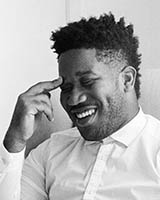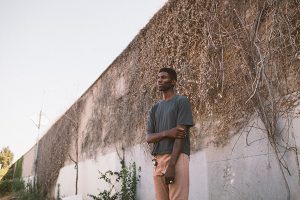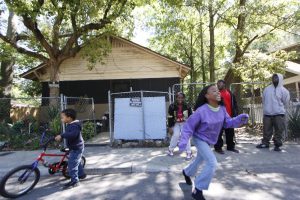ALUMNI: Aundre Larrow Pursues His Dream of Telling Stories…Visually
By Monica Meng, CJC Master’s student
Aundre Larrow, B.S. Journalism and Economics 2013, loved taking photographs in high school, snapping pictures of family and friends, then running to the nearby Walgreens to have them developed. But when he was considering college, he applied to the University of Florida to focus on his writing skills, honing them to better communicate with the world around him. Once there, though, writing exhausted him.
 That was a turning point in Larrow’s life. He changed his focus to photography, challenging himself with creative projects that helped propel his career. After working for companies like Uber and American Express, and shooting fashion shows in New York City, he was accepted as a 2017 Adobe Creative Resident.
That was a turning point in Larrow’s life. He changed his focus to photography, challenging himself with creative projects that helped propel his career. After working for companies like Uber and American Express, and shooting fashion shows in New York City, he was accepted as a 2017 Adobe Creative Resident.
Six years after graduating, Larrow, 27, returned to CJC as part of its Young Alumni Bootcamp Series to share his Adobe experiences with today’s students. During the yearlong residency, he told them, he used his still-evolving audio, video and storytelling skills on an immersive multimedia project called Stories from Here. He traveled the country, visiting towns and cities across America, to delve into how location affects people’s thoughts and identities.
The Brooklyn-based portrait photographer credits his mother with driving him to tell stories in a visual manner. Larrow moved with his mother from Jamaica to South Florida when he was 4 years old.

“My mom was a big believer and likes being able to explain herself fully,” he said. “So whenever I had an idea about something I wanted to do, or a place I wanted to go, or a dream I had, she’d make me draw it or explain it,” Larrow said.
In high school, Larrow fell in love with the images a camera could make.
“Some of my friends painted and drew and played music, and I didn’t really enjoy drawing that much,” Larrow says. “I’d always mess with cameras. When I was a sophomore, I borrowed my friend’s film camera. Back then I lived kind of close to Walgreens, I just walked over there and developed it, and I really started to like doing that. So I just did more of it. Also, I would make those little yearbooks that I really liked for our high school.”
Then, his high school theater teacher gave him a Minolta SRT 101 35mm film camera. That camera sparked his creative energy and helped him develop as an editorial and portrait photographer, a big part of his New York business.

As a journalism major at UF, he found that the writing-intensive life, filled with deadlines, did not allow him time to pursue other interests, like photography. He changed his focus and began shooting photographs for Photo One and The Alligator, which he considered much more appealing.
He also met Journalism Professor John Kaplan, a Pulitzer Prize-winning photographer, who challenged him. He recalls one interaction that upset him at the time, but on which he now considers a defining moment in his career.
Larrow had proposed an idea for a photography project, which Kaplan shot down. “I was taking Advanced Photo II. I remember we used to pitch our second project idea. I said to him I wanted to do a project that is about recording people’s dreams,” Larrow said. “I had this whole idea about making all these little sets and basically trying commercial photography. And he was like, ‘That’s a terrible idea.’ I was really mad about it, but I was also thankful he was clear enough to tell me that. If he hadn’t pushed me enough, who knew if I ever got to try another idea.”
Despite being frustrated, he used the denial to initiate another project, My Neighbors, which featured portraits of people in their neighborhoods. It was a project that made Adobe take notice.

Speaking at CJC in March, Larrow told students they should read more. Read “a lot more than you already read. Read books from people and places you don’t know, regardless (whether) fiction or nonfiction. Try to figure out what kind of voice you want to have. And just realize college ends quickly. Don’t completely waste all your time.”
Students who plan to pursue independent careers, like he has, should start working on projects as freshman, ones “that can be really interesting or immersive … and you don’t see a lot.”
He’s also used his own career to offer the college advice on the courses it should teach to catch up with an ever-evolving media landscape. Those start with skill-based classes.
“If you are an editorial photographer, someone hires you to be able to remove blemishes and smooth skin, or as an editorial writer, you need to take a class like general copywriting. Basically just stuff that is geared toward actual things you are likely to be hired for.”
All communicators should have practical knowledge of Adobe Premiere and Photoshop, general lighting, copywriting and audio gathering. Social media classes that teach posting and strategy are also key.
And there’s one more thing: budgeting, which he called “vital.”
Category: Alumni Profiles, Profiles
Subscribe to our News Digest


